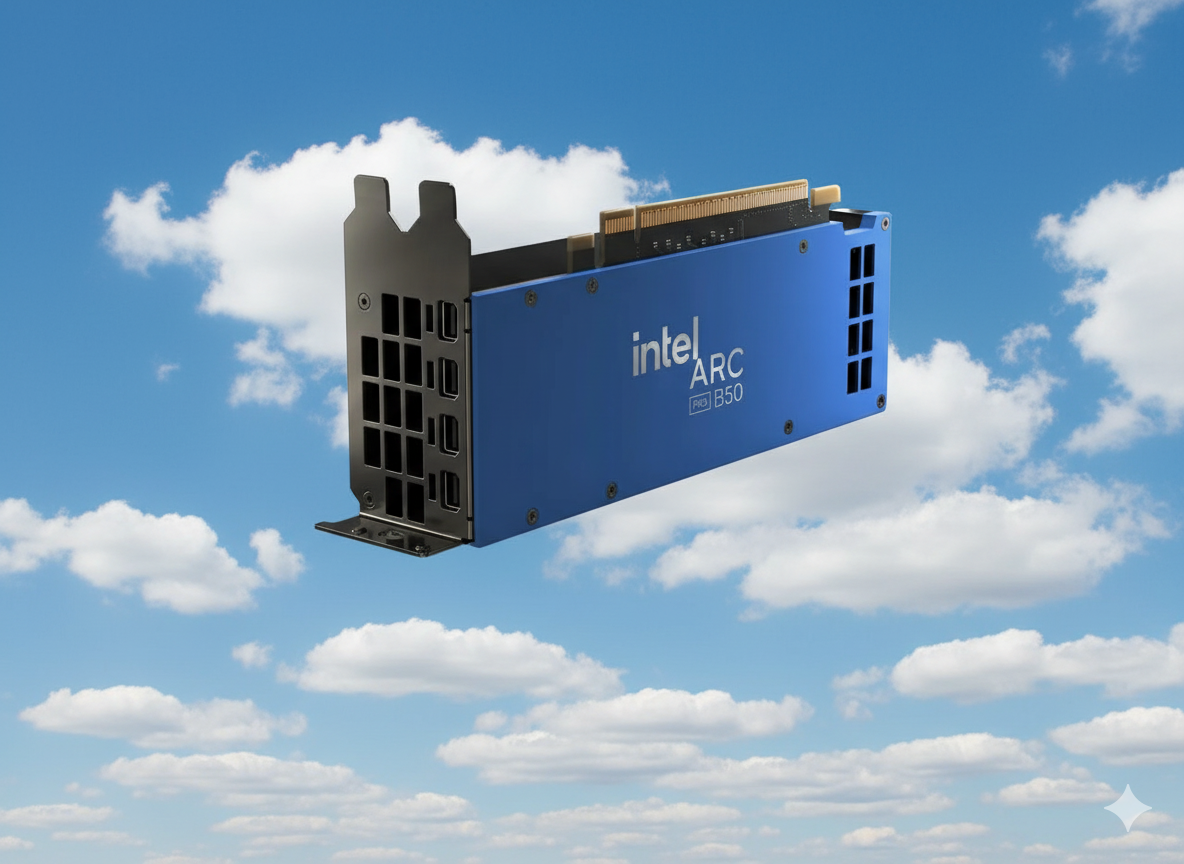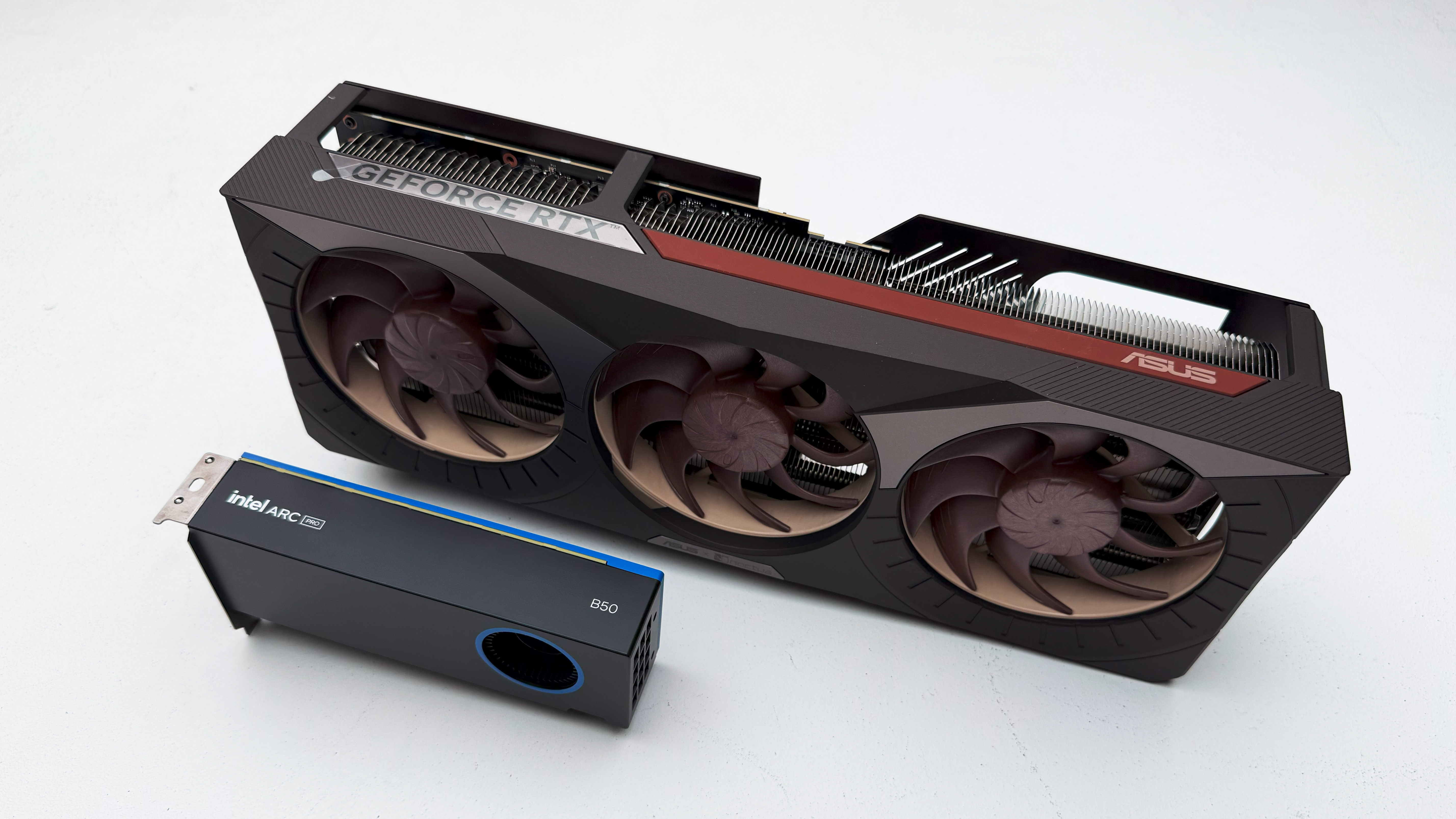Intel has recently made a significant splash in the professional GPU market with the launch of the Arc Pro B50, a compact yet powerful workstation card based on its second-generation Battlemage architecture. Positioned as a challenger to NVIDIA’s RTX A1000 and AMD’s Radeon Pro W7500, the Arc Pro B50 offers competitive performance, a generous 16GB of VRAM, and an attractive price point around $349 — less than half the cost of comparable NVIDIA offerings.
In this article, we’ll explore the technical highlights of the Arc Pro B50, benchmark its performance particularly in AI inference and creative workloads, and compare it to similar GPUs from AMD and NVIDIA—including its intriguing performance on Llama inference tasks.
Technical Overview of Intel Arc Pro B50
- GPU Architecture: Intel’s Xe2 cores on the Battlemage BMG-G21 silicon
- Core Count: 16 Xe2 cores with second-generation Ray Tracing Units and XMX matrix engines for AI workloads
- Memory: 16 GB GDDR6, 128-bit bus, 224 GB/s bandwidth
- Compute Performance: Approx. 10.65 TFLOPS FP32, 170 TOPS INT8 inference
- Power: 70W board power, powered solely by PCIe Gen5 x8 interface (no extra cables needed)
- Display Outputs: Four Mini DisplayPort 2.1 supporting up to 8K resolution
- Form Factor: Compact dual-slot, low-profile design for small form-factor workstations
- Price: Around $349 MSRP[1][2][3][6]
The card is designed for professional workflows including 3D design, video editing, AI inference, and engineering applications, delivering efficiency and performance in a power envelope suitable for compact systems.
Comparison with AMD Radeon Pro W7500 and NVIDIA RTX A1000
| Feature | Intel Arc Pro B50 | NVIDIA RTX A1000 | AMD Radeon Pro W7500 |
|---|---|---|---|
| VRAM | 16 GB GDDR6 | 8 GB GDDR6 | 8 GB GDDR6 |
| Memory Interface & BW | 128-bit, 224 GB/s | 128-bit, ~192 GB/s | 128-bit, ~256 GB/s |
| FP32 Compute | ~10.65 TFLOPS | ~9.5 TFLOPS* | ~9.7 TFLOPS |
| INT8 AI Inference | 170 TOPS | ~120 TOPS (Tensor Cores) | Limited AI-specific cores |
| Power Consumption (TDP) | 70 W | 40 W | 125 W |
| PCIe Interface | PCIe Gen 5 x8 | PCIe Gen 4 x16 | PCIe Gen 4 x16 |
| Price (MSRP) | ~$349 | ~$700+ | ~$700+ |
| Target Use | Entry-level workstation, AI, design | Entry-level workstation, AI, design | Entry-level workstation, CAD and design |
*Various sources estimate RTX A1000 FP32 throughput around 9-10 TFLOPS, exact figures vary by clock.
Key Takeaways:
- The Arc Pro B50 doubles the VRAM capacity compared to NVIDIA and AMD counterparts in this category, which significantly benefits large datasets and model deployments in AI and creative applications[1][2][4].
- While AMD offers slightly higher memory bandwidth, the B50’s boosted AI inference with XMX engines and newer Xe2 architecture provide a performance advantage in AI and compute-heavy pipelines[3][6].
- The B50’s PCIe Gen 5 support and 70W power envelope make it a highly efficient choice for compact and quiet workstations, contrasting with AMD’s higher power draw[1][2].
- Pricing-wise, Intel’s competitive MSRP undercuts similar NVIDIA and AMD cards by nearly 50%, making it accessible for budget-conscious professionals and AI enthusiasts[2][4][7].
Llama Inference Performance
In emerging AI workloads such as running large language models (LLM) like Llama, GPU VRAM and AI acceleration features play a critical role. The Arc Pro B50 stands out with:
- 16GB of VRAM, which comfortably supports medium-sized LLMs without memory swapping that slows down inference[2][6].
- The XMX matrix engines optimized for INT8 precision accelerate transformer computations relevant to LLMs, delivering around 170 TOPS inference performance, which is competitive with NVIDIA’s Tensor cores on RTX A1000 but with more VRAM headroom[3][6].
- Preliminary benchmarks from workstation users indicate the Arc Pro B50 handles Llama model inference at speeds comparable or better than the RTX A1000, especially in multi-threaded environments and Vulkan-accelerated frameworks[3][5].
This makes the Arc Pro B50 an attractive low-cost GPU for AI developers experimenting with local LLM deployments or edge inference scenarios without investing in more expensive professional GPUs.
Conclusion
The Intel Arc Pro B50 is an impressive entrant into the budget workstation GPU market, offering double the VRAM, competitive FP32 and INT8 performance, and excellent power efficiency in a compact design. It challenges NVIDIA’s RTX A1000 and AMD’s Radeon Pro W7500 with a markedly lower price point and strong AI inference capabilities. For creatives, engineers, and AI researchers on a budget, the B50 is proving to be a value-packed choice, especially for workloads demanding larger VRAM and AI acceleration.
Sources and Further Reading
- TechRadar: Intel Arc Pro B50 Review & Comparison to Nvidia RTX A1000
- TweakTown: Intel Arc Pro B50 Becomes Best-Selling Workstation GPU
- Puget Systems Labs: Intel Arc Pro B50 Review
- HotHardware: Best-Selling Workstation GPU Filling AMD/NVIDIA Value Gap
- Level1Techs YouTube Review: Intel Arc Pro B50 – Better Alternative to Nvidia’s A1000
- LTTLabs: Intel Arc Pro B50 16GB Review
- VideoCardz: Intel Arc Pro B50 Becomes Newegg’s Best-Selling Workstation GPU
If you’re considering an entry-level workstation GPU for AI, design, or video workloads in 2025, the Intel Arc Pro B50 is unquestionably worth a close look.

